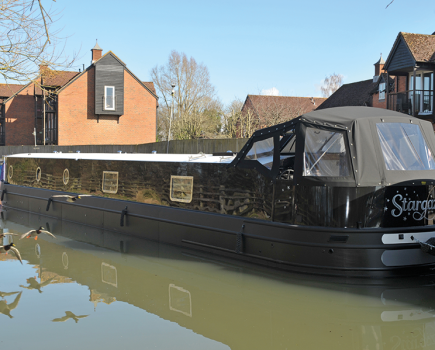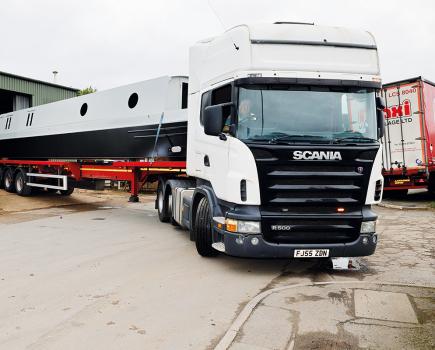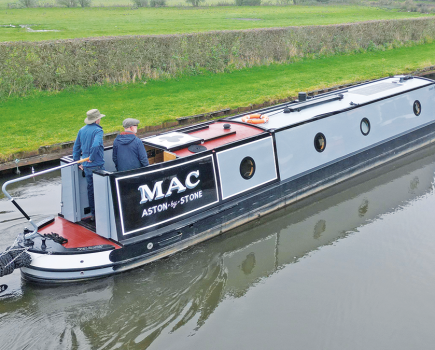Having led the construction and UK delivery of four hybrid tankers from the Far East, former Royal Fleet Auxiliary crewman shows how experience can be invaluable

It’s almost certainly true to say that most people who choose a hybrid drive system for their new boat have relatively little experience of them. While there are more and more hybrid boats being built, they are still vastly outnumbered by diesel powered versions. But when Andrew and Liz Ford chose a hybrid, they knew exactly what they were doing – because Andrew used to work for the Royal Fleet Auxiliary, and oversaw the building of four hybrid tankers. He watched them being constructed in South Korea, and was responsible for bringing them back to the UK, giving him probably more experience of hybrid boats than almost anyone else on the inland waterways.
Liz and Andrew have made plenty of other well-informed choices too. One of the joys of having a boat built to your own design, is that you can move things around. So here’s a boat which is reverse layout – but rather than having the galley at the stern like most reverse layout boats, they wanted the saloon there instead.
And there’s plenty more which makes this boat a bit different. Stannator is built by Ortomarine, who are specialists in electronics and monitoring, so there’s plenty of clever kit on board. Plus there’s an unusual bed arrangement in the cabin, and a composting loo in the bathroom. In short, it’s pretty individual.

Exterior
Stannator is built on a 58ft 6in shell by Tyler Wilson. It’s one of their Mike Christian shells, which means it doesn’t have some of the flourishes of their more expensive boats; for example, rather than complicated scrolls in the handrails, there are simple curves – which still look good. What you do get though, is a pretty bow and the same underwater shape, which means long swims and therefore excellent handling.
This is a gas-free boat, so the bow locker is available for storage. It has a large access lid so folding bikes can fit through, and it’s lockable for security. There are lockers both sides of the well deck to provide storage and seating, and the bow shoreline connection point is hidden inside one of them, giving it some protection from the elements. The water tank is under the well deck.
The doors onto the well deck are a double-glazed, high-security UPVC unit complete with side windows. These doors have become something of an Ortomarine trademark, and their customers seem to love them. The exterior frames are grey, so they blend in better than white ones would. The other windows and portholes throughout the boat are by Caldwells, and are double glazed and have thermal breaks, which should cut down on condensation.

The semi-trad stern also has lockers both sides, so there’s more storage and seating. LED lights are set into the lockers, to light the deck. As well as the engine hole under the deck, there’s a separate compartment across the boat for the large battery bank.
There’s a lot going on on the roof, which has eight large solar panels, a directional TV and radio antenna, wi-fi aerials, a vent for the loo, and a GPS receiver.
The colour scheme of this boat is a classic dark blue, with red coachlines and a cream roof. The name and logo are nicely painted in a panel at the stern. Both reflect the owners’ Devon roots; Stannator is the name for the mayor of Plympton; the design underneath at first looks like an abstract shape, but if you look carefully it’s actually three hares. It’s a design which originates in the Far East, but is most often found in the UK in Devon churches and has a link to tin mining – they’re often called ‘tinners rabbits’.

Layout and fitout
As we’ve already discussed, this is a reverse layout boat – but with the saloon at the stern. Liz and Andrew wanted somewhere with plenty of space to be the natural entrance to the boat, so there’s room to take off wet coats and boots. Next comes the galley, followed by an L-shaped dinette. The separation between the saloon and the dinette means that if you have lots of friends or family to stay on board, there are three distinct sleeping areas. The walk-through bathroom comes next, with the cabin at the bow.
The fitout uses a butt and bead effect below the gunwales, painted in a gentle green colour. Above the gunwales, a marine vinyl is used. This has a 3mm foam backing, which provides a bit of extra insulation, but is also UV stabilised, mildew and stain resistant, and fire retardant. It’s a material which is used a lot in the yachting world, and Ortomarine is pioneering its use in narrowboats. The ceiling is white-painted tongue and groove effect. All the trim is solid oak, while the floor is a Luxury Vinyl Tile in a pale oak effect.
This is a light and bright interior, with bold splashes of colour provided in the soft furnishings. Liz is responsible for the look of the boat inside, and was aiming for something cheerful and colourful. She’s succeeded.

Saloon
We’ll start at the stern, where a set of removable steps leads down from the deck. There’s a radiator behind. On one side is the electrical cupboard, but the door is set back to give somewhere to hang wet coats. Above is the fuse panel and a colour touchscreen which displays masses of information about the boat’s systems. On the opposite side is another cupboard, which has the calorifier in the lower half, and storage above.
Immediately inside the room is a small oak bookcase, with a tv mounted on a bracket above. This is a smart tv, which also has a built-in DVD player. On the other side of the boat is a comfortable sofa bed, with a dimmable wall lamp with a swing arm mounted above. There’s feature lighting under the gunwales.
There’s an attractive slate hearth, with a Hamlet Hardy solid-fuel stove. The flue is only single wall, rather than the double wall recommended in the latest guidelines.

Galley
The galley is another bright modern space, with trendy glossy unit doors in a gentle grey colour. Ortomarine uses Howdens kitchen units, which have a good reputation in the industry. On one side, there’s a full height cupboard which has pullout baskets in the lower half, and fixed shelves above. There’s a range of other cupboards and drawers.
The worktops are made from birch ply, topped with Formica™. Having the layers of ply showing is the trendy thing to do – and it looks good. The sink is a large rectangular single bowl from Howden’s Lamona range, and is teamed with an impressive arched tap.
There’s plenty of equipment on board. With a massive battery bank available, cooking is all electric. There’s a Belling oven, and a two-zone Belling induction hob. The fridge is by Beko, and there’s a mini washing machine by Zanussi hidden in a cupboard.

Dinette
The dinette is L-shaped, with a table on Desmo legs. It converts into a guest double bed by dropping the table down onto shorter legs. Hidden in the end of one of the benches is a small 12 volt freezer.
There are side doors opposite the dinette, with a radiator underneath. On the forward bulkhead is a high level cupboard which contains a modem for on board wi-fi and the boat’s remote monitoring system.

Bathroom
Rather than the shower cubicle we normally see, this boat has a shower bath, complete with a moulded seat and shelf. The walls are lined with white showerwall laminate.
The toilet is a composting model by Compoost. Liz and Andrew first saw composting loos at the Crick Show a few years ago, and liked the idea. They also weren’t keen on carrying round a tank of sewage.
The key to success with this type of toilet is separation between liquids and solids. This loo is designed to manage that separation, with a bottle for liquids and a bucket for solids. It’s equipped with a 12 volt fan, which draws air across the solids to help them dry out. That’s pretty much the only moving part, so there’s little to go wrong, and no ongoing expense. The unit looks very much like a normal toilet; it’s smaller than some of the other makes on the market, which was a big plus for Liz and Andrew; and it feels sturdy enough. Liquids can be emptied at Elsans or down toilets, or (if it’s sufficiently far away from the water) in hedgerows. Solids can be double-bagged and put in the bin. Composting is becoming an increasingly popular option for boat toilets, and with units like this it’s easy to see why.

The basin sits on a glossy corner unit. There’s a mirror above with integral lights. There is a smart grey towel rail on each side of the room.
Cabin
A central door leads into the cabin from the bathroom, and there are wardrobes either side with both shelves and hanging space.
The bed is made up of two halves, both of which lift up out of the way during the day, giving lots of space. It also means that when the bed is down, it’s a full 5ft wide. The bed bases provide storage, and there’s more space in the step up to the well deck. The matresses are made from memory foam.
There are dimmable bedside LED lights, complete with built in USB sockets.
Technical
Stannator is fitted with the top of the range system by Hybrid Marine. It’s based on a Beta 50hp engine (an upgrade from the usual 43hp unit) with a 10kw electric motor bolted on one end. This acts as a motor to drive the prop when in electric mode, and converts into a generator to charge the batteries when the Diesel engine is running. There are two alternators which get a bit hot, so there’s extra cooling in the form of two large pipes with a fan to pull air into the engine hole.
The battery bank, which is in its own compartment separate from the engine hole, consists of 24 two-volt cells, giving a 48 volt supply for the motor – and providing the best part of 800Ah at 48volts. They have watering system fitted, and are a self-venting. There are also two 12 volt batteries, one for the engine starter, and another which powers the 12 volt systems on the boat — such as the lighting and the pumps. There’s a cross-charger to keep these batteries topped up from the 48 volt system. For a 240 volt supply, there’s a 5kw Victron inverter.
The batteries can be charged in a variety of ways. There’s the electric motor when the diesel engine is being used, a shoreline if the boat is in a marina, and eight 160 watt solar panels on the roof.
Ortomarine are experts in the monitoring of all these systems (the boat building firm grew out of an automation and control company) so there’s a touch screen just inside the boat which shows the whole electrical set up, and can tell you in some detail what’s going on — how much power is going in and out of the batteries, and what the state of everything is. And just to show how adaptable the system is, there’s even a sensor on the loo, so the screen will tell you when the bottle needs to be emptied.
The boat is equipped with GPS tracking. Not only does this mean you can tell people where you are, even when you appear to be in the middle of nowhere – the system can also alert you if the boat is moved when you weren’t on board. In addition, the heating system, which is an Eberspacher boiler, can be switched on remotely.
On the water
We tested the boat on both diesel and electric propulsion. With the diesel engine running, there are very few surprises – except perhaps how quiet it is. Switching to the electric motor is simple, really just a matter of turning the diesel engine off.
The electric motor is even quieter. You can hear the water past the boat and being churned by the prop, and you can hear what towpath walkers and your locking crew are saying to you. And it’s while working locks that the system comes into its own, because when you’re waiting for the lock to be set, or while you’re in the lock going up or down, you’re not using any power at all. When you are going along under power, a display tells you what percentage of the available power you’re using, and how much you’re taking from the batteries. At canal speeds, you use very little.
The 10kw electric motor offers you enough power for most situations, but one of the advantages of a hybrid is that you have that big, powerful diesel engine to switch to if you need it. It was very windy on the day of our test, and getting back into the marina berth needed a fair bit of power; where the electric motor felt a little under-powered was when trying to stop the boat going forward. I’d have been happier had we been under diesel power at that point.
The Tyler Wilson shell handles superbly, as we’ve come to expect. It responds very well to the tiller, and goes exactly where it’s pointed.
This is a very individual boat, with lots of features chosen specifically by the owners to suit their needs. Outside it looks rather traditional, but the interior is bright, modern, and stylish.
It’s also loaded with kit, from the hybrid drive system to the very comprehensive monitoring systems which Ortomarine are becoming known for. The firm says a hybrid boat like this starts at £135,000 – and this one, with its extra equipment, came in at a few thousand more. That’s not an unreasonable amount for a boat of this quality, and with this level of specification.
There are some unusual choices in this boat. But all of them, from the hybrid system to the composting loo, have been made with the benefit of knowledge and research. And that’s why it all works so well.
Image(s) provided by:
Archant







